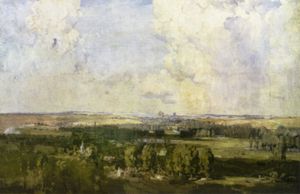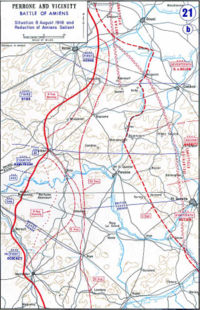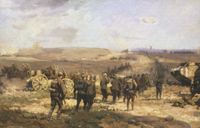Battle of Amiens
2008/9 Schools Wikipedia Selection. Related subjects: Military History and War
| Battle of Amiens | |||||||
|---|---|---|---|---|---|---|---|
| Part of World War I | |||||||
 Amiens, the key to the west by Arthur Streeton, 1918. |
|||||||
|
|||||||
| Belligerents | |||||||
| Commanders | |||||||
| Strength | |||||||
| 5 Australian divisions, 4 Canadian divisions, 3 British divisions, 1 American division, 12 French divisions, 1,900 aircraft, 532 tanks |
25 active divisions, 4 reserve divisions, 365 aircraft |
||||||
| Casualties and losses | |||||||
| 22,200 dead, wounded, or missing | 74,000 dead, wounded, missing, or captured | ||||||
|
|||||
The Battle of Amiens, which began on 8 August 1918, was the opening phase of the Allied offensive later known as the Hundred Days Offensive that ultimately led to the end of World War I. Allied forces advanced over seven miles on the first day, one of the greatest advances of the war. The battle is also notable for its effects on both sides' morale and the large number of surrendering German forces. This led Erich Ludendorff to famously describe the first day of the battle as "the black day of the German Army." Amiens was one of the first major battles involving armoured warfare and marked the end of trench warfare on the Western Front; fighting becoming mobile once again until the armistice was signed on 11 November 1918.
Prelude
On 21 March 1918, the German Empire had launched Operation Michael, the first in a series of attacks planned to drive the Allies back along the length of the Western Front. Michael was intended to defeat the right wing of the British Expeditionary Force, but lack of success before Arras ensured the ultimate failure of the offensive. A final effort was aimed at the town of Amiens, a vital railway junction, but the advance had been halted at Villers-Bretonneux by the Australians on 4 April. Subsequent German offensives — Operation Georgette ( 9 April- 11 April), Operation Blücher-Yorck ( 27 May), Operation Gneisenau ( 9 June) and Operation Marne-Rheims ( 15 July— 17 July) — all made advances elsewhere on the Western Front, but failed to achieve a decisive breakthrough.
At the end of the Marne-Rheims offensive, Allied commander Maréchal Ferdinand Foch ordered a counteroffensive which led to the Second Battle of the Marne. The Germans, recognising their untenable position, withdrew from the Marne to the north. Foch now tried to move the Allies back onto the offensive.
Plan
Foch disclosed his plan on 23 July 1918 following the German retreat that had begun on 20 July. The plan called for reducing the Saint-Mihiel salient (which would later see combat in the Battle of Saint-Mihiel) and liberating the railroad lines that ran through Amiens.
The commander of the British Expeditionary Force, Field Marshal Sir Douglas Haig, already had plans in place for an attack near Amiens. When the British retreat had ended in April, the headquarters of British Fourth Army under General Sir Henry Rawlinson had taken over the front astride the Somme. North of the river were British III Corps under Lieutenant General Richard Butler, while south of the river were the Australian Corps under Sir John Monash. (On May 30, all the Australian infantry divisions were united under the Corps HQ, for the first time on the Western Front). The Australians had mounted a number of local counter-attacks which both revealed the suitability of the open and firm terrain south of the Somme for a larger offensive and also established and refined the methods which were to be used.
Rawlinson had submitted Monash's proposals to Haig in July and Haig had forwarded them to Foch. At a meeting on July 24, Foch agreed to the plan but insisted that the French First Army, which held the front to the south of the British Fourth Army, should participate. Rawlinson had opposed this as his and Monash's plans depended on the large-scale use of tanks to achieve surprise and make preliminary bombardment unnecessary. The French First Army lacked tanks and would be forced to bombard the German positions before the infantry advance began, thus removing the element of surprise. Eventually, it was agreed that the French would participate, but not launch their attack until 45 minutes after Fourth Army. It was also agreed to advance the proposed date of the attack from August 10 to August 8, to strike the Germans before they had completed their withdrawal from the Marne salient.
Rawlinson had already finalised his plans in discussion with his Corps commanders (Butler, Monash, Sir Arthur Currie of the Canadian Corps and Lieutenant General Charles Kavanagh of the Cavalry Corps) on July 21. The final plan for Fourth Army involved 1,386 guns and howitzers, making up 27 medium artillery brigades and 13 heavy batteries, in addition to the infantry divisions' artillery. There were also to be 580 tanks.
The tactical methods had been tested by the Australians in a local counter-attack at the Battle of Hamel on July 4. The German defenders of Hamel were deeply dug in, and their position commanded a very wide field of fire. Similar positions had resisted capture for two months in the Battle of the Somme. The Australians had used surprise rather than weight at Hamel. The artillery had opened fire only at the moment the infantry and tanks advanced, and the Germans were rapidly overrun.
A key factor in the final plan was secrecy. There was to be no pre-battle bombardment, only artillery fire immediately prior to the advance of Australian, Canadian, and British forces. The fire plan for Fourth Army's artillery was devised by Monash's senior artillery officer, Major General C.E.D. Budworth. Advances in artillery techniques and aerial photographic reconnaissance made it possible to dispense with "ranging shots" to ensure accurate fire. Budworth had produced a timetable which allowed every single German position to be hit at "zero hour", while a creeping barrage preceded the infantry. This method was similar to the Feuerwalze which the Germans themselves had used in their Spring Offensive, but its effectiveness was increased by the surprise achieved.
On a larger scale, the Allies had successfully moved the Canadian Corps of four infantry divisions to Amiens without them being detected by the Germans. A detachment from the Corps of two infantry battalions, a wireless unit and a casualty clearing station had been sent to the front near Ypres to bluff the Germans that the entire Corps was moving north to Flanders. The Corps was not fully in position until August 7. To maintain secrecy, the Allies commanders pasted the notice "Keep Your Mouth Shut" into orders issued to the men, and never used the actual word "offensive".
Preliminaries
Although the Germans were still on the offensive in late July 1918, the Allied armies were growing in strength, as more American units arrived in France, and British reinforcements were transferred from the Mediterranean. The German commanders realized in early August that their forces might be forced on the defensive, though Amiens was not considered to be a likely front. The Germans believed the French would probably attack the Saint-Mihiel front east of Reims, or in Flanders near Mount Kemmel, while they believed the British would attack along either the Lys or near Albert. The Allies had indeed mounted a number of local counter-offensives in these sectors, both to gain local objectives to improve their defensive positions and to distract attention from the Amiens sector. German forces began to withdraw from the Lys and other fronts in response to these theories. The Allies maintained equal artillery and air fire along their various fronts, moving troops only at night, and faking movements during the day to mask their actual intent.
The German front east of Amiens was held by their Second Army under General Georg von der Marwitz, with six divisions in line (and two facing the French 1st Army). There were only two divisions in immediate reserve. There was some concern among the Allies on August 6 when the German 27th Division actually attacked north of the Somme on part of the front on which the Allies planned to attack two days later. The German division (a specially selected and trained Stosstruppen formation) penetrated roughly 800 yards (730 m) into the one-and-a-half mile front. This attack was made in retaliation for the repeated Australian trench raids south of the Somme which had gained many prisoners and affected the morale of the "Trench" divisions the Germans had stationed there. The German division moved somewhat back to its original position on the morning of August 7, but the movement still required changes to the Allied plan.
Battle
The battle began in dense fog at 4:20 AM on 8 August 1918. Under Rawlinson's Fourth Army, the British III Corps attacked north of the Somme, the Australian Corps to the south of the river in the centre of Fourth Army's front, and the Canadian Corps to the south of the Australians. The French 1st Army under General Debeney opened its preliminary bombardment at the same time, and began its advance 45 minutes later, supported by a battalion of 72 Whippet tanks. Although German forces were on the alert, this was largely in anticipation of possible retaliation for their incursion on the 6th and not because they had learned of the preplanned Allied attack. Although the two forces were within 500 yards (460 m) of one another, gas bombardment was very low, as the bulk of the Allied presence was unknown to the Germans. The attack was so unexpected that German forces only began to return fire after five minutes, and even then at the positions where the Allied forces had assembled at the start of the battle and had long since left.
In the first phase, seven divisions attacked: the British 18th (Eastern) and 58th (2/1st London), the Australian 2nd and 3rd, and the Canadian 1st, 2nd and 3rd. The Canadian and Australian attackers were supported by eight battalions of the Royal Tank Corps, with a paper strength of 216 Mark V and 72 Mark V*, with 48 unarmed tanks used as supply-carrying tractors. Parts of the American 33rd Division supported the British attackers north of the Somme.
The attackers captured the first German position, advancing about 4,000 yards (3,700 m) by about 7:30 AM. In the centre, supporting units following the leading divisions attacked the second objective a further two miles (3 km) distant. Australian units reached their first objectives by 7:10 AM, and by 8:20 AM, the Australian 4th and 5th and the Canadian 4th divisions passed through the initial hole in the German line. The third phase of the attack was assigned to infantry-carrying Mark V* tanks. However, the infantry was able to carry out this final step unaided. The Allies penetrated well to the rear of the German defences and cavalry now continued the advance, one brigade in the Australian sector and two cavalry divisions in the Canadian sector. RAF and armoured car fire kept the retreating Germans from rallying.
The Canadian and Australian forces in the centre advanced quickly, pushing the line 3 miles (4.8 km) forward from its starting point by 11 AM. The speed of their advance was such that a party of officers and some divisional staff that were eating breakfast were captured. A gap 15 miles (24 km) long was punched in the German line south of the Somme by the end of the day. There was less success north of the river, where the British III Corps had only a single tank battalion in support, the terrain was rougher and the German incursion of the 6th had disrupted some of the preparations. Although the attackers gained their first objectives, they were held up short of the Chipilly spur, a steep wooded ridge.
The British Fourth Army took 13,000 prisoners while the French captured a further 3,000. Total German losses were estimated to be 30,000 on 8 August. The Fourth Army's casualties, British, Australian and Canadian infantry, were approximately 8,800, exclusive of tank and air losses and their French allies.
German Army Chief of Staff Paul von Hindenburg noted the Allies' use of surprise and that Allied destruction of German lines of communication had hampered potential German counter-attacks by isolating command positions. The German general Erich Ludendorff described the first day of Amiens as the "Schwarzer Tag des deutschen Heeres" ("the black day of the German Army"), not because of the ground lost to the advancing Allies, but because the morale of the German troops had sunk to the point where large numbers of troops began to capitulate. Five German divisions had effectively been engulfed. Allied forces pushed, on average, seven miles (11 km) into enemy territory by the end of the day. The Canadians gained 8 miles (13 km), Australians 7 miles (11 km), British 2 miles (3.2 km), and the French 5 miles (8.0 km).
Later fighting
The advance continued, though not with the spectacular results of the first day. The infantry had outrun the supporting artillery and the initial force of more than 500 tanks that played a large role in the Allied success. The Germans on Chipilly Spur commanded a wide field of fire to the south of the Somme, and their flanking fire held up the Australian Corps until late on the 9th, when a small Australian party slipped across the river, and captured the village of Chipilly itself, together with a renewed attack by III Corps. On the Canadian front, congested roads and communication problems prevented the British 32nd Division being pushed forward rapidly enough to maintain the momentum of the advance.
On 10 August, there were signs that the Germans were pulling out of the salient from Operation Michael. According to official reports, the Allies had captured nearly 50,000 prisoners and 500 guns by 27 August. Even with the lessened armour the British drove 12 miles (19 km) into German positions by 13 August.
Aftermath
The Battle of Amiens was a major turning point in the tempo of the war. The Germans had started the offensive with the Schlieffen Plan before the war devolved into trench warfare, the Race to the Sea slowed movement on the Western Front, and the German Spring Offensive earlier that year had once again given Germany the offensive edge on the Western Front. Armoured support helped the Allies tear a hole through trench lines, weakening once impregnable trench positions. The British Third army with no armored support had almost no effect on the line while the Fourth with less than a thousand tanks broke deep into German territory, for example. Australian commander John Monash was knighted by King George V in the days following the battle.
British war correspondent Philip Gibbs noted Amiens' effect on the war's tempo, saying on 27 August that "the enemy...is on the defensive" and "the initiative of attack is so completely in our hands that we are able to strike him at many different places." Gibbs also credits Amiens with a shift in troop morale, saying "the change has been greater in the minds of men than in the taking of territory. On our side the army seems to be buoyed up with the enormous hope of getting on with this business quickly" and that "there is a change also in the enemy's mind. They no longer have even a dim hope of victory on this western front. All they hope for now is to defend themselves long enough to gain peace by negotiation."

